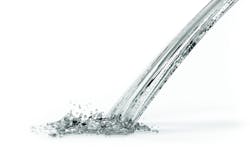To alleviate any worry about the odor or taste of water, identify the source to ensure drinking water is safe and clean. Several reasons could explain an odd taste or odor.
In the U.S. tap water is generally safe to drink because it is regulated and often screened for dangerous pollutants. In fact, water authorities are required to share Consumer Confidence Reports with their residents. However, water can be contaminated at several possible contamination points en route from the water treatment plant to the tap.
An unwanted odor coming from drinking water is often the sign of greater issues afflicting the tap or pipelines. Often it does not signify the presence of a harmful contaminant, but it could indicate that the distribution system requires flushing or other maintenance. Sometimes water may taste like metal or have an odor like chlorine or bleach. Part 2 of this series examines some of the most common complaints about water in the U.S., methods to help identify the source of the problem and a way to correct it.
Bleach odor
Because public water sources are treated with chlorine, drinking water can sometimes exude an odor similar to bleach or a swimming pool when water is over chlorinated. Small amounts of chlorine are added to public water sources and treatment plants to eliminate traces of bacteria, viruses and parasites as the water travels to its point of use. The U.S. Environmental Protection Agency requires that chlorine levels in public water systems be maintained at a range that is detectable but not above 4 milligrams per liter (mg/L). Most people will detect a bleach smell if the chlorine level is around 1 mg/L. If the bleach or chlorine odor is strong, the local water source could add extra chlorine to keep the water clean for longer lengths of time to cover longer distances.
The strength of this chlorine scent will usually depend on the distance of a public water source from a household. However, the odor can also be affected by the temperature of the water because colder water can hold on to chlorine for longer. Exposures to levels below 4 mg/L do not pose a risk to your health, but it is relatively easy to eliminate the smell with time or a carbon water filter. Chilling it in the refrigerator or adding a slice of lemon or orange will remove the bleach odor from the water. Many water suppliers use chloramine residuals in their distribution systems. Chloramines have less taste and odor than free chlorine at similar concentrations.
Musty odor
While generally safe to use and drink, water with a musty odor can in rare circumstances be attributed to pollution. Algal blooms in the source water often contribute a musty taste. For users of city water supplies a musty smell often results from sediment leaching into the plumbing system. Over time, decaying organic matter in the source can produce earthy aromas. Similarly, severely corrosive water in pipes may cause trace amounts of copper, iron or even lead to appear in water, adversely affecting its taste.
Dirt taste
If water tastes like potting soil, it may have been invaded by geosmin, also called algal blooms. Geosmin is prevalent in the summer months and grows on the surface of bodies of water, such as lakes and reservoirs. Although not toxic, geosmin can cause an earthy taste if it makes its way into your drinking water. If bacteria could be the cause of the problem, start by testing to see if every faucet in the house has the same dirt-like taste or if it is an isolated tap. That may help detect whether the fault lies with an entire plumbing system or a lone tap. If it is a single source, the aerator, the tiny cylinder screwed to the end of your faucet, may be dirty. Empty it and rinse it out.
Metal taste
If tap water has a metallic taste, it is likely caused by either excess corrosivity or trace minerals in the water supply, possibly due to rusty city or residential pipes. Trace metals such as iron, manganese, zinc and copper are all common contaminants. If pipes are old check if they are galvanized iron If well water is used, the culprit is more than likely iron caused by seepage or corrosion or excess metal in groundwater.
The normal pH range is 6.5 to 8.5. If water tastes like metal, it is best to have it tested to determine whether the pH is too high or too low and to determine find out the root of the problem. Determining if the metal taste is harmful depends on the source. Slight excess Iron and zinc, for example, tend to have no ill side effects. Excess iron or manganese will stain laundry. You should also check to see if your water has excess lead.
Recommendations
Water with a foul taste or odor does not have to be the end of refreshing drinking water. A better alternative to drinking straight from the tap is using a point of use (POU) water filtration system that is certified to remove taste and odor. There are also bottle-less water coolers that connect directly to a building’s water supply and purify water upon dispense and offer options such as cold, hot, and sparkling water.
Most POU systems use a carbon filter to remove contaminants, chlorine, and other waterborne bad tastes and odors. For additional filtration, POU systems can use a 1 micron activated carbon block filter certified for lead and cyst removal, which have a solid carbon rod to remove contaminants including lead, cysts, chlorine, sediment, taste, odor and organic contaminants. To ensure a greater level of purity, water specialists recommend treating all drinking water with a carbon filter and ultraviolet (UV) purification to keep bacteria at bay.
Looking back at all the causes of odors and tastes examined, bacteria can be a cause. The most effective way to ensure water is free from bacteria in a public water supply is to be sure that it meets drinking water standards. If it is a private well have it tested to bacterial and chemical drinking water standards. If your water meets standards but has an off taste or odor, a POU water filtration system could improve the taste if you cannot solve the problem by the techniques described above. Look for systems certified to ANSI/NSF 42.
For part one in this series, click here.
Lisa VanWyngarden is senior marketing manager for Waterlogic USA. Waterlogic is a designer, manufacturer, distributor and operator of mains-attached POU drinking water purification and dispensing systems designed for environments such as offices, factories, hospitals, hotels, schools, restaurants and other workplaces. For more information, visit waterlogicusa.com. VanWyngarden may be reached at [email protected].


